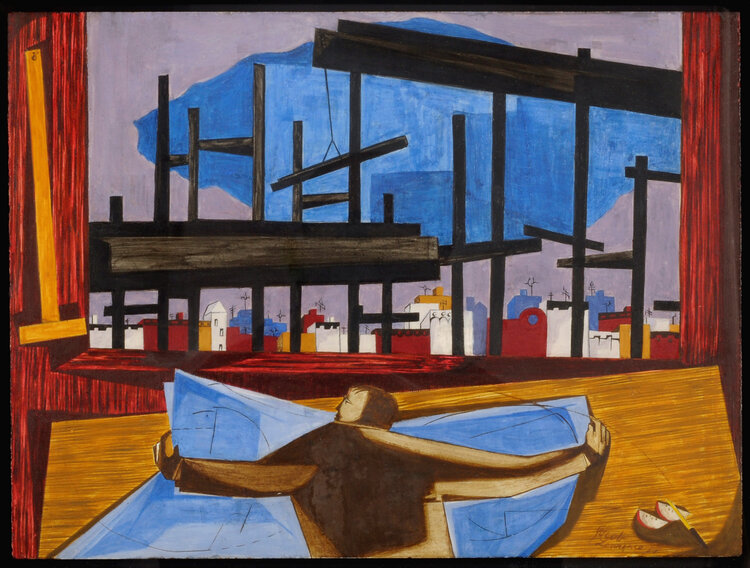This activity is developed for children ages 8 and above. Download and print this activity guide for easy reference.
GET INSPIRED
How might your neighborhood look in the future? To explore this question, we will explore an artwork together and imagine the future of our community. This activity features a work of art from Black Refractions: Highlights from The Studio Museum in Harlem, a special exhibition at the Frye Art Museum through August 15, 2021.

Jacob Lawrence. The Architect, 1959. Egg tempera on Masonite. 13 5/8 × 17 1/2 in. The Studio Museum in Harlem; gift of Mr. and Mrs. James Harithas 1982.1. © 2021 The Jacob and Gwendolyn Knight Lawrence Foundation, Seattle / Artists Rights Society (ARS), New York. Photo Credit: Marc Bernier
Jacob Lawrence is one of the most influential African-American painters of the twentieth century. Lawrence grew up in Harlem, New York and moved to Seattle in the 1970s to teach in the School of Art at the University of Washington. Even though he identified as a New Yorker, he spent the last three decades of his life in his adopted home of Seattle until he passed in 2000.
His paintings often feature primary colors and bold geometric shapes as he simplified his subject matter to abstract forms while expressing different social themes. He is best known for his 60-panel series of paintings, The Great Migration. Throughout his career, Lawrence focused on the themes of labor, construction, and African-American history and historical figures.
Learn more about The Architect on The Studio Museum in Harlem’s website.
Take a moment to look closely at this artwork
-
What is going on in this work? What’s the first thing you notice in this painting?
-
This painting is called The Architect. An architect is someone who designs buildings and may also supervise their construction. Find the architect in this painting. What do you think the architect might be doing with his outstretched arms at a drafting table?
-
The architect is holding a blueprint in his hands. A blueprint is a design plan or technical drawing. While we can’t see the drawing itself, what do you think the drawing might show? What do you think is being built in front of the architect?
-
What do you think the architect is thinking while holding the blueprint? Based on his facial expression and body language, how do you think he might be feeling in this moment?
-
Rhythm is one of the seven principles of design that suggests movement or action in an artwork that comes from repeating elements of art, such as lines shapes, or colors. In this painting, Lawrence created a visual tempo that provides a path for your eyes to follow. Can you spot this rhythm? What did he use to create the rhythm?
-
Red, yellow, and blue are primary colors. How many different shades of blue can you find in this painting? What other colors can you find that are not primary colors?
MAKE SOME ART
Now it’s your turn to be an architect. Use your imagination and create your neighborhood 20 years in the future. You will first create a blueprint of your neighborhood by sketching out your ideas on paper before building it in 3D.
You will need:
-
Paper for sketching
-
Pencil, colored pencils, or markers
-
Clay, cardboard, fabric, wire, and other materials that could be used for making 3D objects
-
Found objects, such as toy cars, Lego bricks, water bottles, or boxes.
Let’s get started
-
Start sketching what your neighborhood might look like 20 years in the future on a blank sheet of paper.
-
What types of spaces can be found in your neighborhood? Are there houses, apartment buildings, stores, restaurants, parks, or something else? Who is using these different spaces in your neighborhood?
-
What types of new spaces might you add to your future neighborhood? How might these new spaces benefit different people living in your neighborhood? What might these spaces look like?
-
Which parts of your neighborhood do you hope will still be around in 20 years? How might these parts change or improve your neighborhood?
-
Which parts of your neighborhood make it feel like a community? A sense of community is a feeling of belonging. How might you make your future neighborhood feel like a community?
-
Will you include yourself as the architect of your future neighborhood in your drawing? If so, where might you position yourself in the drawing?
-
-
Once you’ve completed the drawing of what your neighborhood will look like in the future, let’s use it as a blueprint for a sculpture or installation.
-
Based on your drawing, how might you create your neighborhood three-dimensionally?
-
What kinds of found objects might you use to represent the different elements in your drawing?
-
If you need to create your own elements for your neighborhood, what kinds of materials might you use? For example, you can cut out cardboard pieces to represent buildings in your sculpture or use felt to represent a park.
-
-
Now you can arrange everything to represent buildings, structures, green spaces, and other elements in your neighborhood. Does it look and feel the way you imagined it would on paper?

SHARE YOUR WORK
Here is an example of what an imaginary neighborhood could look like in the future with found objects.
How did your future neighborhood turn out? Please share it with us on social media using the hashtag #FryeFromHome.
Lynn Chou
Manager of Youth and School Programs
Alexa Villanueva
2020 University of Washington, Museum Studies Certificate Program Intern